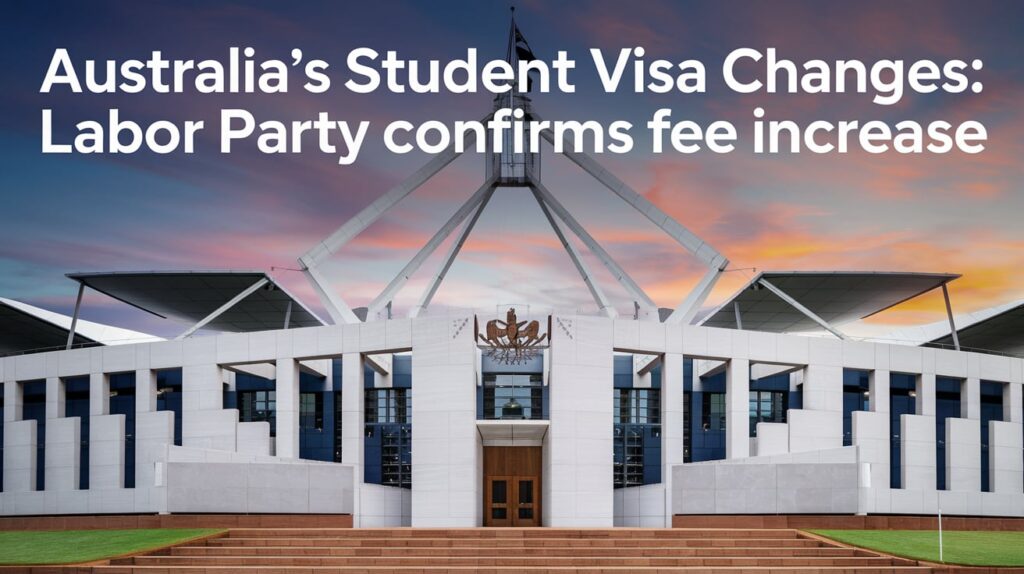
Australia’s Student Visa Changes: Labor Party Confirms Fee Increase
Introduction
Australia has long been a preferred destination for international students, offering world-class education, diverse cultural experiences, and promising post-graduation opportunities. In 2024 alone, over one million international students were enrolled in Australian institutions, contributing significantly to the nation’s economy.
However, recent developments have introduced changes to the student visa policies. The ruling Labor Party has announced plans to increase the international student visa fee from A$1,600 to A$2,000, aiming to regulate the growing education sector and manage net migration. This move is part of a broader strategy to address housing pressures and ensure the sustainability of Australia’s immigration system.
This blog aims to provide a comprehensive overview of these recent changes, delve into the political context, and explore the potential implications for prospective international students considering Australia as their study destination.
Background: Australia’s International Education Landscape
Significance of International Students to Australia’s Economy
International education stands as a cornerstone of Australia’s economy. In the 2023–24 financial year, the sector contributed approximately A$50.5 billion, encompassing tuition fees, accommodation, living expenses, and other services. This positions international education as Australia’s fourth-largest export industry, following iron ore, coal, and natural gas.
International education plays a vital role in advancing Australia’s social power as it attracts international students who are beyond economic value. Australia gains international respect through its environment, which combines international students with cultural sharing and international diplomacy.
Previous Student Visa Fee Structures
Historically, Australia’s student visa fees were relatively moderate. However, on 1 July 2024, the Australian government implemented a significant increase, raising the student visa application fee from A$710 to A$1,600. This adjustment aimed to reflect the growing value of education in Australia and to fund initiatives in education and migration.
Recent Trends in International Student Enrollments
International student enrollments keep rising in Australia each year. The most extensive recorded enrollment of student visa holders reached 608,262 on June 30, 2024. International students have gained massive prominence in the Australian educational sector and economic landscape.
The recent changes to visa fees together with policy modifications have created doubts among various stakeholders. The increased tuition fees make educational institutions apprehensive about student enrollment because potential students may be discouraged from studying.
The Announced Fee Increase
Details of the Proposed Fee Hike from A$1,600 to A$2,000
In April 2025, Australia’s ruling Labor Party announced plans to raise the international student visa application fee from A$1,600 to A$2,000 if re-elected. This follows a significant increase in July 2024, when the fee more than doubled from A$710 to A$1,600.
The proposed increase to A$2,000 is part of Labor’s pre-election strategy and would be implemented upon their re-election. The previous increase to A$1,600 took effect on July 1, 2024 .
Comparison with Previous Fee Increases
- Pre-July 2024: A$710
- From July 1, 2024: A$1,600 (an increase of over 125%)
- Proposed (Post-2025 Election): A$2,000
These increases position Australia’s student visa fees as some of the highest globally, surpassing those of the U.S. (approximately $185) and Canada (approximately C$150) .
Government’s Rationale Behind the Increase
The Labor government justifies the fee hikes as measures to:
- Reflect the increasing value of education in Australia
- Restore integrity in the international education sector
- Fund key initiatives, including:
- Reforms recommended by the Universities Accord
- Financial support for apprentices and their employers
- Implementation of the Migration Strategy
Additionally, the government aims to regulate the growing education sector and manage net migration, addressing concerns about housing pressures and ensuring the sustainability of Australia’s immigration system .
Political Context and Opposition Stance
Labor Party’s Position and Justifications
The Australian Labor Party has announced plans to increase international student visa fees from A$1,600 to A$2,000 if re-elected. This policy aims to generate approximately A$760 million over four years, contributing to budget improvements and funding initiatives such as additional bulk-billed GP visits and mental health services.
Labor justifies the fee hike as a measure to reflect the value of Australian education and to manage the growing international education sector. The party also plans to cap new international student enrollments at 270,000 in 2025 to address housing pressures and ensure the sustainability of Australia’s immigration system.
Opposition’s Proposed Fee Increases and Policies
The opposition Coalition has proposed more substantial changes, including increasing student visa fees to a minimum of A$2,500, with fees reaching up to A$5,000 for top-tier universities. Additionally, they plan to cap new international student arrivals at 240,000 per year.
The Coalition argues that these measures will alleviate housing pressures and ensure that international students are genuine and committed to their studies. They also propose increasing international students’ work allowance from 45 to 60 hours per fortnight, aiming to generate additional tax revenue.
Debates Surrounding the Impact on International Education
These proposed changes have sparked debates among stakeholders in the education sector. Universities Australia and other education providers express concern that higher visa fees and stricter caps on student numbers could deter prospective international students, potentially impacting enrollment numbers and the broader economy.
Critics argue that the fee increases make Australia a less attractive destination for international students, especially when compared to countries like the U.S. and Canada, where visa fees are significantly lower. There are also concerns that increasing work allowances may shift the focus from education to employment, undermining the quality of education and the integrity of the student visa program.